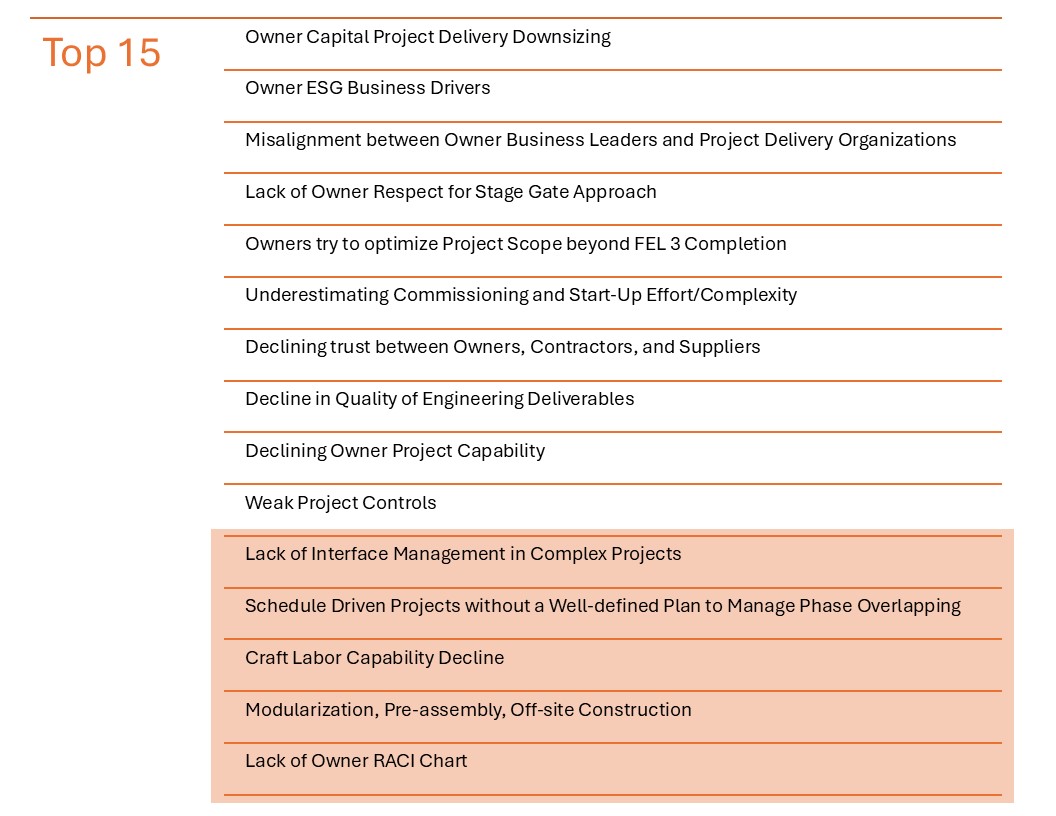As we conclude our series on Project Management Disruptors, we turn our attention to five emerging challenges that are increasingly shaping the future of Capital Project Execution. These Disruptors—ranging from Interface Management Gaps to the Evolving Role of Modularization—require thoughtful strategies and proactive leadership. Let’s explore Disruptors 11 through 15 and how organizations can respond effectively.

Eleventh – Lack of Interface Management in Complex Projects
In today’s large-scale, multi-stakeholder projects, the absence of robust interface management can lead to miscommunication, scope gaps, and costly rework. As projects grow in complexity, so do the number of interfaces—between disciplines, contractors, vendors, and systems. To address this, the following solutions can be implemented:
- Dedicated Interface Managers: For large capital projects, assign interface managers early in the project lifecycle to ensure effective coordination across all defined interfaces.
- Interface Registers: Create and maintain a detailed interface register—similar to a risk register—to document responsibilities, track dependencies, and monitor key deliverables across teams and systems.
- Integrated Planning Tools: Use digital collaboration platforms to visualize and manage interfaces in real time.
- Regular Interface Reviews: Incorporate structured interface discussions into recurring project meetings to proactively resolve conflicts and maintain alignment across teams.
Twelfth – Schedule-Driven Projects Without a Well-Defined Plan to Manage Phase Overlapping
Many projects are fast-tracked to meet aggressive timelines, often overlapping phases like engineering, procurement, and construction without a clear strategy. This can result in design changes during construction, procurement delays, and increased risk exposure. To mitigate this, consider these strategies:
- Phase Overlap Planning: Develop a detailed plan that identifies which elements can be safely overlapped and which require completion before proceeding.
- Risk-Based Decision Making: Use risk assessments to guide decisions on phase overlaps, ensuring that critical path activities are protected.
- Progressive Design Freeze: Implement progressive design freezes to lock in key deliverables before construction begins.
- Scenario Planning: Use simulations to test different overlap strategies and their impact on schedule and cost.
Thirteenth – Craft Labor Capability Decline
The industry is facing a significant decline in skilled craft labor due to retirements, lack of training, and reduced interest among younger generations. This shortage threatens productivity, quality, and safety on job sites. To address these challenges, consider the following solutions:
- Workforce Development Programs: Partner with trade schools and unions to invest in training and apprenticeship programs.
- Retention Strategies: Enhance working conditions, offer competitive compensation, and establish clear career pathways to retain skilled workers. Focus on long-term employment opportunities rather than project-based hiring and layoffs.
- Technology Integration: Leverage automation, robotics, and digital tools to enhance efficiency and supplement the workforce. These innovations not only improve productivity but also help attract the next generation of skilled craft labor.
- Early Contractor Involvement: Involve contractors early in the planning process to evaluate labor availability and align resources effectively. This also supports the implementation of an Advanced Work Packaging (AWP) strategy to improve project execution and productivity.
Fourteenth – Modularization, Pre-assembly, Off-site Construction
While modularization and off-site construction bring clear advantages—such as enhanced safety, improved quality, and greater schedule certainty, it also addresses the skilled labor shortage by shifting work from the construction site to controlled fabrication environments, reducing reliance on on-site labor. However, they also present new challenges in logistics, design coordination, and interface management. To address these challenges, consider the following tactics:
- Modularization Feasibility Studies: Conduct early assessments to determine which components are suitable for off-site fabrication.
- Design for Modularization (DfMA): Integrate modular thinking into the design process from the outset.
- Logistics Planning: Develop detailed logistics and transportation plans to manage module delivery and site integration.
- Interface Coordination: Ensure tight coordination between module fabricators and site teams to avoid fit-up issues.
Fifteenth – Lack of Owner RACI Chart
Without a clear RACI (Responsible, Accountable, Consulted, Informed) chart, confusion often arises over decision-making authority, accountability, and communication pathways. This can lead to delays, duplication of effort, and missed opportunities. To keep things streamlined, owners can implement the following strategies:
- Develop a RACI Early: Develop a RACI chart during the FEL2 or FEL3 phase and keep it updated as the project progresses. Be sure to include early engagement from engineering and construction contractors, as well as potential vendors, to ensure alignment and accountability from the start.
- Communicate Roles Clearly: Ensure all stakeholders understand their roles and responsibilities through onboarding and regular reviews.
- Align with Governance: Integrate the RACI chart into the project governance framework to support decision-making and accountability.
- Use RACI in Meetings: Reference the RACI chart in project meetings to clarify ownership of actions and decisions.
Conclusion
The landscape of project management continues to evolve, shaped by growing complexity, rapid technological advancement, and shifting workforce dynamics. By proactively addressing these final five Disruptors—interface management, phase overlap planning, labor capability, modularization, and role clarity—alongside the ten previously explored, organizations can better position themselves for long-term project success.
This marks the conclusion of our Project Management Disruptors series. We hope these insights have offered valuable guidance for navigating today’s challenges and tomorrow’s opportunities. For your convenience, we’ve compiled the entire series into one comprehensive article—your go-to resource for staying agile, informed, and purpose-driven in project leadership. You can request your copy here!

